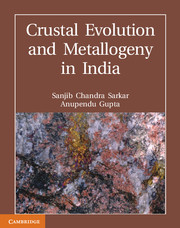Book contents
- Frontmatter
- Dedication
- Contents
- List of Figures
- List of Tables
- List of Plates
- Preface
- Chapter 1 Southern India
- Chapter 2 Central India
- Chapter 3 Eastern Ghat Belt
- Chapter 4 Eastern India
- Chapter 5 North-East India
- Chapter 6 Western India
- Chapter 7 The Himalaya
- Chapter 8 Crustal Evolution and Metallogeny in India: A Brief Review in the Context of the World Scenario
- References
- Index
- Plate Section
Chapter 5 - North-East India
Published online by Cambridge University Press: 05 February 2014
- Frontmatter
- Dedication
- Contents
- List of Figures
- List of Tables
- List of Plates
- Preface
- Chapter 1 Southern India
- Chapter 2 Central India
- Chapter 3 Eastern Ghat Belt
- Chapter 4 Eastern India
- Chapter 5 North-East India
- Chapter 6 Western India
- Chapter 7 The Himalaya
- Chapter 8 Crustal Evolution and Metallogeny in India: A Brief Review in the Context of the World Scenario
- References
- Index
- Plate Section
Summary
Geology and Crustal Evolution
Introduction
North-Eastern India, comprising seven states of the Indian Union, viz, Assam, Arunachal, Meghalaya, Nagaland, Mizoram, Manipur and Tripura, geologically represents a collage of different tectonic blocks with distinctive geological history (Fig. 5.1.1).
The central part of the terrain constitutes the Shillong–Mikir Precambrian massif (Meghalaya plateau and Mikir Hills of Assam), representing the north-eastern continuation of the Chhotanagpur Gneissic Complex (CGC) across the Bengal Basin (Ganges–Brahmaputra valley). The Dauki Fault demarcates the southern boundary of the plateau, while the northern and eastern edges are covered by alluvials of the Brahmaputra river valley in the Assam plains. Several inselbergs of the basement jut out in the Brahmaputra alluvial plains, of which those at Goalpara and Dhubri are the most prominent. The eastern most segment of the Himalaya including the ‘Eastern Himalayan Syntaxis’ (occupying Arunachal Pradesh) and the Indo-Burman Range (IBR) passing through Nagaland–Manipur, binds the region along its north and east. Along the west of the IBR, there are N–S to NE–SW trending Neogene molasse sediments of shelf facies, the southern parts of which make up the low hill ranges of Tripura–Mizoram. The Bengal Basin (Rajmahal–Garo Hills gap) intervenes between the Indian Peninsular shield and the North-Eastern region, though with uninterrupted continuation of the Himalayan Range along the northern territory.
- Type
- Chapter
- Information
- Crustal Evolution and Metallogeny in India , pp. 526 - 541Publisher: Cambridge University PressPrint publication year: 2012



